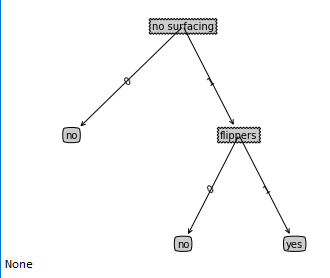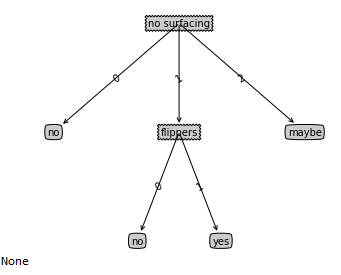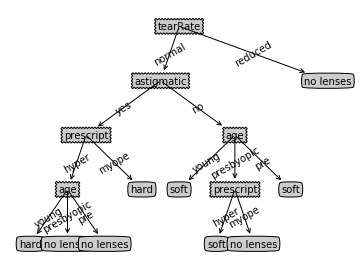1、构建决策树的过程:
from math import log #海洋生物数据,x1为不浮出水面是否可以生存,x2为是否有脚蹼,y为是否属于鱼类 def createDataSet(): dataSet = [[1, 1, 'yes'], [1, 1, 'yes'], [1, 0, 'no'], [0, 1, 'no'], [0, 1, 'no']] labels = ['no surfacing','flippers'] return dataSet, labels #计算给定数据集的熵 def calcShannonEnt(dataSet): #计算数据集中实例的总数 numEntries = len(dataSet) labelCounts = {} for featVec in dataSet: #将y取出 currentLabel = featVec[-1] #创建一个数据字典,它的键值是最后一列的数值,如果当前键值不存在,则将当前键值加入字典 if currentLabel not in labelCounts.keys(): labelCounts[currentLabel] = 0 #每个键值都记录了当前类别出现的次数 labelCounts[currentLabel] += 1 shannonEnt = 0.0 for key in labelCounts: #计算所有类标签发生的概率,本例:yes:2/5,no:3/5 prob = float(labelCounts[key])/numEntries #计算信息熵 shannonEnt -= prob * log(prob,2) #log base 2 return shannonEnt #调用 #调用函数createDataSet() myDat,labels = createDataSet() print('构建的数组:',myDat) print('x的名称分别为:',labels) #调用函数calcShannonEnt(dataSet) p = calcShannonEnt(myDat) print('构建的数组中y的熵:',p) #p为熵,y中混合的数据种类越多,熵越大,下面测试这一论断 myDat[0][-1] = 'maybe' print('对y增加一个种类,修改第一个y:',myDat) p = calcShannonEnt(myDat) print('对y增加一个种类,发现y的熵变大了:',p) #恢复原样 myDat[0][-1] = 'yes' print('将数组恢复原样:',myDat) print('………………') #划分数据集,使用了三个参数:待划分的数据集,划分数据集的特征,需要返回的特征的值 def splitDataSet(dataSet, axis, value): #创建新的列表 retDataSet = [] #遍历待划分的数据集 for featVec in dataSet: #如果满足待划分数据集中的某个值等于需要返回的值的条件 if featVec[axis] == value: #将待划分的数据集分成两部分 reducedFeatVec = featVec[:axis] reducedFeatVec.extend(featVec[axis+1:]) retDataSet.append(reducedFeatVec) return retDataSet #调用,取第0个位置等于1的元素,不包括1本身 s1 = splitDataSet(myDat, 0, 1) print('取第0个位置等于1的元素,不包括1本身:',s1) #调用,取第0个位置等于0的元素,不包括0本身 s2 = splitDataSet(myDat, 0, 0) print('取第0个位置等于0的元素,不包括0本身',s2) print('………………') #选择最好的数据集划分方式 def chooseBestFeatureToSplit(dataSet): #取x的种类数(columns数量) numFeatures = len(dataSet[0]) - 1 #计算整个数据集的原始熵 baseEntropy = calcShannonEnt(dataSet) bestInfoGain = 0.0; bestFeature = -1 #迭代所有x的column for i in range(numFeatures): #将当前列取出 featList = [example[i] for example in dataSet] #将当前列去重 uniqueVals = set(featList) newEntropy = 0.0 #迭代去重后的当前列 for value in uniqueVals: #取当前列等于value的值的元素,不包括value值本身 subDataSet = splitDataSet(dataSet, i, value) #当前列等于value的值的概率 prob = len(subDataSet)/float(len(dataSet)) #计算所有特征值的熵之和 newEntropy += prob * calcShannonEnt(subDataSet) #判断信息增益,取信息增益最大的那个索引值 infoGain = baseEntropy - newEntropy if (infoGain > bestInfoGain): bestInfoGain = infoGain bestFeature = i return bestFeature #调用 #返回信息增益最大的那个索引值 best_x_index = chooseBestFeatureToSplit(myDat) print('信息增益最大的那个索引值为:',best_x_index) print('………………') #返回出现次数最多的分类名称 import operator def majorityCnt(classList): classCount={} for vote in classList: if vote not in classCount.keys(): classCount[vote] = 0 #每个键值都记录了当前类别出现的次数 classCount[vote] += 1 #表示为对classCount中第1维的元素进行降序排序 sortedClassCount = sorted(classCount.iteritems(), key=operator.itemgetter(1), reverse=True) return sortedClassCount[0][0] #创建树,两个输入参数:数据集合标签列表 def createTree(dataSet,labels): #取y值 classList = [example[-1] for example in dataSet] #代码第一个停止条件是类标签完全相同,count()函数是统计某元素出现的次数,该例为统计y中第一个数出现的次数 if classList.count(classList[0]) == len(classList): return classList[0] #如果只有一个y的column,则返回y中出现次数最多的类别 if len(dataSet[0]) == 1: return majorityCnt(classList) #开始创建树 #返回信息增益最大的那个索引值 bestFeat = chooseBestFeatureToSplit(dataSet) #返回信息增益最大的列名称 bestFeatLabel = labels[bestFeat] myTree = {bestFeatLabel:{}} del(labels[bestFeat]) #将信息增益最大的那列放到featValues中 featValues = [example[bestFeat] for example in dataSet] uniqueVals = set(featValues) for value in uniqueVals: #复制所有标签,使树不会弄乱所有标签 subLabels = labels[:] #运用递归,直到类标签完全相同或只有一个y的column为止 myTree[bestFeatLabel][value] = createTree(splitDataSet(dataSet, bestFeat, value),subLabels) return myTree #调用 myTree = createTree(myDat,labels) print('将递归过程展现出来:',myTree) print('………………') #使用决策树执行分类,遍历整棵树,比较testVec变量中的值与树节点的值, #如果达到叶子节点,则返回testVec位置的分类 #三个参数:第一个决策树字典,第二个x的column标签,第三个参数测试变量 def classify(inputTree,featLabels,testVec): firstStr = list(inputTree.keys())[0] secondDict = inputTree[firstStr] #查找当前列表中第一个匹配firstStr变量的元素 featIndex = featLabels.index(firstStr) key = testVec[featIndex] valueOfFeat = secondDict[key] if isinstance(valueOfFeat, dict): classLabel = classify(valueOfFeat, featLabels, testVec) else: classLabel = valueOfFeat return classLabel #调用 tree0 = {'no surfacing': {0: 'no', 1: {'flippers': {0: 'no', 1: 'yes'}}}} labels = ['no surfacing','flippers'] print('将测试数据导入:',tree0) print('将测试数据导入:',labels) print('[1,0]对应的分类标签为:',classify(tree0,labels,[1,0])) print('[1,1]对应的分类标签为:',classify(tree0,labels,[1,1])) print('………………') #使用pickle模块存储决策树 def storeTree(inputTree,filename): import pickle fw = open(filename,'wb') pickle.dump(inputTree,fw) fw.close() def grabTree(filename): import pickle fr = open(filename,'rb') return pickle.load(fr) #调用 storeTree(tree0,'F://python入门//文件//classifierStorage.txt') print('将序列化对象取出:',grabTree('F://python入门//文件//classifierStorage.txt'))
结果:
构建的数组: [[1, 1, 'yes'], [1, 1, 'yes'], [1, 0, 'no'], [0, 1, 'no'], [0, 1, 'no']] x的名称分别为: ['no surfacing', 'flippers'] 构建的数组中y的熵: 0.9709505944546686 对y增加一个种类,修改第一个y: [[1, 1, 'maybe'], [1, 1, 'yes'], [1, 0, 'no'], [0, 1, 'no'], [0, 1, 'no']] 对y增加一个种类,发现y的熵变大了: 1.3709505944546687 将数组恢复原样: [[1, 1, 'yes'], [1, 1, 'yes'], [1, 0, 'no'], [0, 1, 'no'], [0, 1, 'no']] ……………… 取第0个位置等于1的元素,不包括1本身: [[1, 'yes'], [1, 'yes'], [0, 'no']] 取第0个位置等于0的元素,不包括0本身 [[1, 'no'], [1, 'no']] ……………… 信息增益最大的那个索引值为: 0 ……………… 将递归过程展现出来: {'no surfacing': {0: 'no', 1: {'flippers': {0: 'no', 1: 'yes'}}}} ……………… 将测试数据导入: {'no surfacing': {0: 'no', 1: {'flippers': {0: 'no', 1: 'yes'}}}} 将测试数据导入: ['no surfacing', 'flippers'] [1,0]对应的分类标签为: no [1,1]对应的分类标签为: yes ……………… 将序列化对象取出: {'no surfacing': {0: 'no', 1: {'flippers': {0: 'no', 1: 'yes'}}}}
2、使用mapplotlib注解绘制树形图
尝试绘制一个简单的有向图:
import matplotlib.pyplot as plt #定义决策结点形状 decisionNode = dict(boxstyle="sawtooth", fc="0.8") #定义叶结点形状 leafNode = dict(boxstyle="round4", fc="0.8") #设置箭头样式 arrow_args = dict(arrowstyle="<-") #执行绘图功能 #创建绘图函数,有四个参数:文字描述,定位点(目标点),起始点,节点类型 def plotNode(nodeTxt, centerPt, parentPt, nodeType): #nodeTxt:(x,y)处注释文本,xy:是要添加注释的数据点的位置 #xytext:是注释内容的位置。textcoords='axes fraction' #bbox:是注释框的风格和颜色深度,fc越小,注释框的颜色越深,支持输入一个字典 #va="center", ha="center"表示注释的坐标以注释框的正中心为准,而不是注释框的左下角(v代表垂直方向,h代表水平方向) #xycoords和textcoords可以指定数据点的坐标系和注释内容的坐标系(本例为距离轴坐标左下角的数字分数),通常只需指定xycoords即可,textcoords默认和xycoords相同 #arrowprop:这个属性主要是用来画出xytext的文本坐标点到xy注释点坐标点的箭头指向线段 createPlot.ax1.annotate(nodeTxt, xy=parentPt, xycoords='axes fraction', xytext=centerPt, textcoords='axes fraction', va="center", ha="center", bbox=nodeType, arrowprops=arrow_args ) #创建了一个新图形并清空绘图区,然后在绘图区上绘制两个代表不同类型的树节点 def createPlot(): #figure 命令,能够创建一个用来显示图形输出的一个窗口对象,指定了背景色为白色 fig = plt.figure(1, facecolor='white') # Clear figure清除所有轴,但是窗口打开,这样它可以被重复使用。 fig.clf() #subplot()用于直接指定划分方式和位置进行绘图, plt.subplot(111)表示将整个图像窗口分为1行1列, 当前位置为1 #叠加图层时frameon必须设置成False,不然会覆盖下面的图层 createPlot.ax1 = plt.subplot(111, frameon=False) plotNode('a decision node', (0.5, 0.1), (0.1, 0.5), decisionNode) plotNode('a leaf node', (0.8, 0.1), (0.3, 0.8), leafNode) plt.show() #调用 print('尝试绘制一个简单的图形:',createPlot()) print('………………')
结果输出:

尝试绘制一个简单的图形: None
………………
绘制一个复杂的树形图:
import matplotlib.pyplot as plt #定义决策结点形状 decisionNode = dict(boxstyle="sawtooth", fc="0.8") #定义叶结点形状 leafNode = dict(boxstyle="round4", fc="0.8") #设置箭头样式 arrow_args = dict(arrowstyle="<-") #执行绘图功能 #创建绘图函数,有四个参数:文字描述,定位点(目标点),起始点,节点类型 def plotNode(nodeTxt, centerPt, parentPt, nodeType): #nodeTxt:(x,y)处注释文本,xy:是要添加注释的数据点的位置 #xytext:是注释内容的位置。textcoords='axes fraction' #bbox:是注释框的风格和颜色深度,fc越小,注释框的颜色越深,支持输入一个字典 #va="center", ha="center"表示注释的坐标以注释框的正中心为准,而不是注释框的左下角(v代表垂直方向,h代表水平方向) #xycoords和textcoords可以指定数据点的坐标系和注释内容的坐标系(本例为距离轴坐标左下角的数字分数),通常只需指定xycoords即可,textcoords默认和xycoords相同 #arrowprop:这个属性主要是用来画出xytext的文本坐标点到xy注释点坐标点的箭头指向线段 createPlot.ax1.annotate(nodeTxt, xy=parentPt, xycoords='axes fraction', xytext=centerPt, textcoords='axes fraction', va="center", ha="center", bbox=nodeType, arrowprops=arrow_args ) #创建了一个新图形并清空绘图区,然后在绘图区上绘制两个代表不同类型的树节点 #def createPlot(): # #figure 命令,能够创建一个用来显示图形输出的一个窗口对象,指定了背景色为白色 # fig = plt.figure(1, facecolor='white') # Clear figure清除所有轴,但是窗口打开,这样它可以被重复使用。 # fig.clf() #subplot()用于直接指定划分方式和位置进行绘图, plt.subplot(111)表示将整个图像窗口分为1行1列, 当前位置为1 #叠加图层时frameon必须设置成False,不然会覆盖下面的图层 # createPlot.ax1 = plt.subplot(111, frameon=False) # plotNode('a decision node', (0.5, 0.1), (0.1, 0.5), decisionNode) # plotNode('a leaf node', (0.8, 0.1), (0.3, 0.8), leafNode) # plt.show() #调用 #print('尝试绘制一个简单的图形:',createPlot()) print('………………') #获取叶节点的数目 def getNumLeafs(myTree): #将叶节点数目放到numLeafs中 numLeafs = 0 #取第一个key值 firstStr = list(myTree.keys())[0] #取第一个value值 secondDict = myTree[firstStr] #遍历key值 for key in secondDict.keys(): #如果value值为字典,则进行此计算 if type(secondDict[key]).__name__=='dict': #进行递归运算 numLeafs += getNumLeafs(secondDict[key]) else: numLeafs +=1 return numLeafs #获取数的层数 def getTreeDepth(myTree): maxDepth = 0 firstStr = list(myTree.keys())[0] secondDict = myTree[firstStr] for key in secondDict.keys(): if type(secondDict[key]).__name__=='dict': thisDepth = 1 + getTreeDepth(secondDict[key]) else: thisDepth = 1 if thisDepth > maxDepth: maxDepth = thisDepth return maxDepth #输出预先存储的树信息 def retrieveTree(i): listOfTrees =[{'no surfacing': {0: 'no', 1: {'flippers': {0: 'no', 1: 'yes'}}}}, {'no surfacing': {0: 'no', 1: {'flippers': {0: {'head': {0: 'no', 1: 'yes'}}, 1: 'no'}}}} ] return listOfTrees[i] #调用 tree0 = retrieveTree(0) print('取出一个树样例:',tree0) print('叶节点的数目:',getNumLeafs(tree0)) print('树的层数:',getTreeDepth(tree0)) print('………………') #计算父节点和子节点的中间位置,有三个参数:子节点位置,父节点位置,文本标签 def plotMidText(cntrPt, parentPt, txtString): xMid = (parentPt[0]-cntrPt[0])/2.0 + cntrPt[0] yMid = (parentPt[1]-cntrPt[1])/2.0 + cntrPt[1] createPlot.ax1.text(xMid, yMid, txtString, va="center", ha="center", rotation=30) #绘制树形图 def plotTree(myTree, parentPt, nodeTxt): #将计算的叶节点放到numLeafs中 numLeafs = getNumLeafs(myTree) # depth = getTreeDepth(myTree) #第一个节点记为firstStr firstStr = list(myTree.keys())[0] #计算子节点的位置 cntrPt = (plotTree.xOff + (1.0 + float(numLeafs))/2.0/plotTree.totalW, plotTree.yOff) #计算子节点与父节点的中间位置 plotMidText(cntrPt, parentPt, nodeTxt) #执行绘图功能 plotNode(firstStr, cntrPt, parentPt, decisionNode) #取第一个value值 secondDict = myTree[firstStr] #调整y的位置 plotTree.yOff = plotTree.yOff - 1.0/plotTree.totalD #遍历子节点 for key in secondDict.keys(): #如果子节点的value值是字典类型 if type(secondDict[key]).__name__=='dict': #进行递归 plotTree(secondDict[key],cntrPt,str(key)) #如果子节点的value值不是字典类型,则执行以下操作 else: #增加全局变量x的偏移 plotTree.xOff = plotTree.xOff + 1.0/plotTree.totalW #执行绘图功能 plotNode(secondDict[key], (plotTree.xOff, plotTree.yOff), cntrPt, leafNode) #计算子节点与父节点的中间位置 plotMidText((plotTree.xOff, plotTree.yOff), cntrPt, str(key)) #增加全局变量y的偏移 plotTree.yOff = plotTree.yOff + 1.0/plotTree.totalD #准备数据 def createPlot(inTree): #figure 命令,能够创建一个用来显示图形输出的一个窗口对象,指定了背景色为白色 fig = plt.figure(1, facecolor='white') # Clear figure清除所有轴,但是窗口打开,这样它可以被重复使用。 fig.clf() axprops = dict(xticks=[], yticks=[]) #subplot()用于直接指定划分方式和位置进行绘图, plt.subplot(111)表示将整个图像窗口分为1行1列, 当前位置为1 #叠加图层时frameon必须设置成False,不然会覆盖下面的图层 createPlot.ax1 = plt.subplot(111, frameon=False, **axprops) #存储树的宽度 plotTree.totalW = float(getNumLeafs(inTree)) #存储树的深度 plotTree.totalD = float(getTreeDepth(inTree)) #plotTree.xOff、plotTree.yOff追踪已经绘制的节点位置以及放置下一个节点的恰当位置 plotTree.xOff = -0.5/plotTree.totalW; plotTree.yOff = 1.0; #调用plotTree plotTree(inTree, (0.5,1.0), '') plt.show() #调用 myTree = retrieveTree(0) print(createPlot(myTree)) print('………………') myTree['no surfacing'][2] = 'maybe' print(myTree) print(createPlot(myTree))
结果:
……………… 取出一个树样例: {'no surfacing': {0: 'no', 1: {'flippers': {0: 'no', 1: 'yes'}}}} 叶节点的数目: 3 树的层数: 2 ………………

……………… {'no surfacing': {0: 'no', 1: {'flippers': {0: 'no', 1: 'yes'}}, 2: 'maybe'}}

3、使用以上代码,预测隐形眼镜数据
import sys sys.path.append(r'C://Users//91911//.spyder-py3') import trees #使用决策树预测隐形眼镜类型 f = open('F://python入门//文件//machinelearninginaction//Ch03//lenses.txt') #将文本数据的每一个数据行按照tab键分割,并依次存入lenses lenses = [inst.strip().split(' ') for inst in f.readlines()] #创建并存入特征标签列表 lensesLabels=['age','prescript','astigmatic','tearRate'] #根据继续文件得到的数据集和特征标签列表创建决策树 lensesTree=trees.createTree(lenses,lensesLabels) print(lensesTree)from treePlotter import createPlot #生成决策树 treePlotter.createPlot(lensesTree)
结果:
{'tearRate': {'normal': {'astigmatic': {'yes': {'prescript': {'hyper': {'age': {'young': 'hard', 'presbyopic': 'no lenses', 'pre': 'no lenses'}}, 'myope': 'hard'}}, 'no': {'age': {'young': 'soft', 'presbyopic': {'prescript': {'hyper': 'soft', 'myope': 'no lenses'}}, 'pre': 'soft'}}}}, 'reduced': 'no lenses'}}

4、一些解释说明
annotate函数详细参数解释:
import matplotlib.pyplot as plt # plt.annotate(str, xy=data_point_position, xytext=annotate_position, # va="center", ha="center", xycoords="axes fraction", # textcoords="axes fraction", bbox=annotate_box_type, arrowprops=arrow_style) # str是给数据点添加注释的内容,支持输入一个字符串 # xy=是要添加注释的数据点的位置 # xytext=是注释内容的位置 # bbox=是注释框的风格和颜色深度,fc越小,注释框的颜色越深,支持输入一个字典 # va="center", ha="center"表示注释的坐标以注释框的正中心为准,而不是注释框的左下角(v代表垂直方向,h代表水平方向) # xycoords和textcoords可以指定数据点的坐标系和注释内容的坐标系,通常只需指定xycoords即可,textcoords默认和xycoords相同 # arrowprops可以指定箭头的风格支持,输入一个字典 # plt.annotate()的详细参数可用__doc__查看,如:print(plt.annotate.__doc__)
figure函数
matlab中的 figure 命令,能够创建一个用来显示图形输出的一个窗口对象